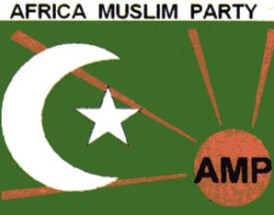 image by Bruce Berry, 21
May 2009
image by Bruce Berry, 21
May 2009
Last modified: 2013-11-11 by bruce berry
Keywords: south africa | political parties | amp | anc | acdp | azapo | cdp | konserwatiewe party | democratic alliance | democratic party | economic freedom movement |
herstigte nasionale party | independent democrats | inkatha |
Links: FOTW homepage |
search |
disclaimer and copyright |
write us |
mirrors
Pages of other major South African political parties:
 image by Bruce Berry, 21
May 2009
image by Bruce Berry, 21
May 2009The Africa Muslim Party (AMP) was formed in 1994 in order to participate in South Africa's first democratic elections. AMP believes in maximum powers to the people on the ground and regards the devolution powers from the centre to the provinces and communities as essential based on morality, religious freedom, the abolition of poverty and hunger, improving the social environment in which the diverse beliefs, customs and languages are promoted. The AMP promotes free and fair trading conditions, fighting nepotism and corruption and the provision of better education facilities, health care, housing and free services to the poor and needy. AMP will promote adult education to increase literacy in the society and to promote small and medium size business and start up entrepreneurs in business that are beneficial to the majority of the people. Finally, the AMP will fight racism and bigotry at all levels and promote tolerance and understanding.
The AMP logo has a green field with a white crescent moon
and five point star in the hoist. A tan coloured ball, from which four tan
coloured rays radiate, is in the lower fly. The letters AMP are
superimposed in black over the ball and the full name of the party is written
above.
image by Bruce Berry, 21
May 2009
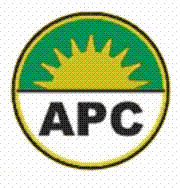 image
sent by Bruce Berry, 11 May 2009
image
sent by Bruce Berry, 11 May 2009
The APC was formed in 2007 and had two seats in the National Assembly until
April 2009. The APC is underpinned by the philosophies of:
1) Pan-Africanism - a socio-political world view which seeks to unify and uplift
both native Africans and those of the African diasporas as part of a "global
African community";
2) socialism - a socio-economic system in which property and the distribution of
wealth are subject to control by the community; and
3) African Nationalism and continental unity. The APC stands for one unified
Africa.
According to its election manifesto, then principles of the party are:
* To rally the people to defend and advance the right to National
self-determination.
* To strive for an Africanist Socialist Democracy.
* To strive and promote the ideal of the Union of African States, including the
African Diaspora.
* To strive and promote international solidarity among progressive forces.
* To strive and promote the advancement of the interests of the people,
educationally, culturally and economically.
* To strive and promote the projection of the African personality.
The APC uses the same colours of black, green and gold as does the
African National Congress and
Pan-African Congress parties. The party's logo is in the form of a circle
divided horizontally with the top half showing a yellow rising sun against a
green background. The lower half has the party initials in black against a white
background.
Bruce Berry, 11 May 2009
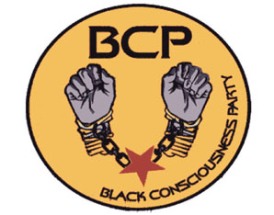 image
sent by Bruce Berry, 29 June 2009
image
sent by Bruce Berry, 29 June 2009
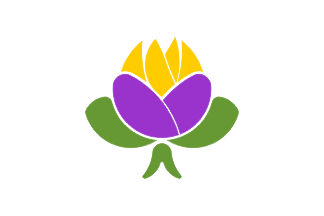 image by Martin
Grieve, 17 Dec 2003
image by Martin
Grieve, 17 Dec 2003
The Economic Freedom Movement is a new libertarian political party in South Africa.
Its emblem, in the form of a green, purple and yellow flower can be found
this website.
Gary Selikow, 17 Dec 2003
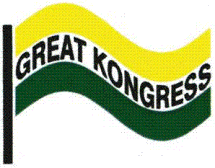 image sent by Bruce Berry, 03 May 2009
image sent by Bruce Berry, 03 May 2009
The Great Kongress of South Africa (GKSA) was launched in 2007 in Soweto and
according to its leader, Vinesh Chuturgoon, it has 150 000 members. The party is
aiming for 26 seats in the National Parliament in the current election. Its
leader previously served as chairperson of the Inkatha Freedom Party's executive
committee and as a Ward Councillor of Ward 4 in Newcastle (KwaZulu-Natal).
GKSA strongly believes in socialism and its motto is 'equality for all'.
According to the party, its main aim is to fight crime and ensure that the youth
participate in various empowerment programmes.
The GKSA logo takes the form of a wavy flag comprising three horizontal stripes
of yellow, white and green with part of the name of the party, "GREAT KONGRESS",
in the centre of the white stripe. On the national ballot the words "of SA" are
written under the logo.
Bruce Berry, 03 May 2009
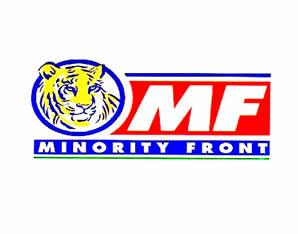 image
by Bruce Berry, 04 May 2009
image
by Bruce Berry, 04 May 2009
Although the Minority Front (MF) claims to represent all the minorities of South
Africa, its support comes almost entirely from South Africa's Indian community
in Kwazulu-Natal. The party stands for the absence of
discrimination and inequality with regard to minority groups and co-operation
between races. The party is headed by Amichand Rajbansi, a former Chief Minister
of the House of Delegates tricameral parliamentary chamber for Indians in the
pre-1994 political dispensation. The MF had two seats in the National Assembly
and is also represented in the eThekwini
Metropolitan Council in Durban.
The party logo has a stylised head of a Bengal Tiger followed by the letters
"MF" in white on a red stripe, with the full name of the party in white on a
blue stripe below, underneath all of which is a thin green
stripe, all on a white background.
Bruce Berry, 04 May 2009
The flag of the liberal the EZPZ New Generation Political Party is shown on
their website.
Gary Selikow, 16 Dec 2003
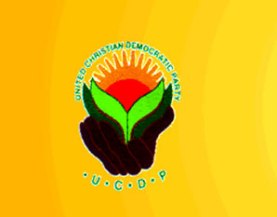 image sent by Bruce Berry, 29 June 2009
image sent by Bruce Berry, 29 June 2009
The UCDP is contesting the 2009 South African general elections with a modified banner. The emblem of the party is now slightly off centre on a yellow background, and not a horizontal bi-colour as mentioned by Gary Selikow below. The emblem of the party remains unchanged.
The United Christian Democratic Party (UCDP) was formed by Lucas Mangope, the
former President of the "homeland" of Bophuthatswana.
Mangope was among the first homeland leaders to accept so-called independence
for the seTswana-speaking people. The UCDP was the only party allowed to operate
in the territories under his control.
According to its election manifesto, the
vision of the UCDP is to be the leading party in uniting all South Africans,
Christians and non-Christians alike, in a truly democratic, non-racial and
non-sexist partnership inspired by the desire to work together in a diverse
society in building a prosperous and free nation.
Bruce Berry, 29 June 2009
The United Christian Democratic Party is a moderate Christian Democratic Party in South Africa.
The emblem in the center of the the flag can be found at www.ucdp.org.za on the top left hand of the website.
The flag has the same dimensions of the Indonesian flag , with 2 bands, orange at the top (where their would be red on the Indonesian flag) and white at the bottom, with the UCDP emblem in the center of the flag. The emblem in the center is prominent and
the same size as the emblem on the Cypriot flag.
Gary Selikow, 16 Dec 2003
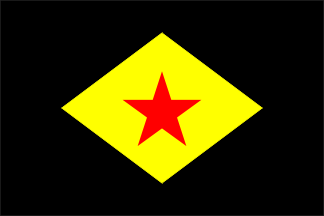 image
by Martin Grieve, 17 Dec 2003
image
by Martin Grieve, 17 Dec 2003
The flag of the Workers Party in South Africa can be found in the middle of their
website.
When the emblem is used as a flag. It is flown in the usual flag dimensions with the emblem in the middle, being the red star on the
yellow diamond on a black background.
Gary Selikow, 16 Dec 2003